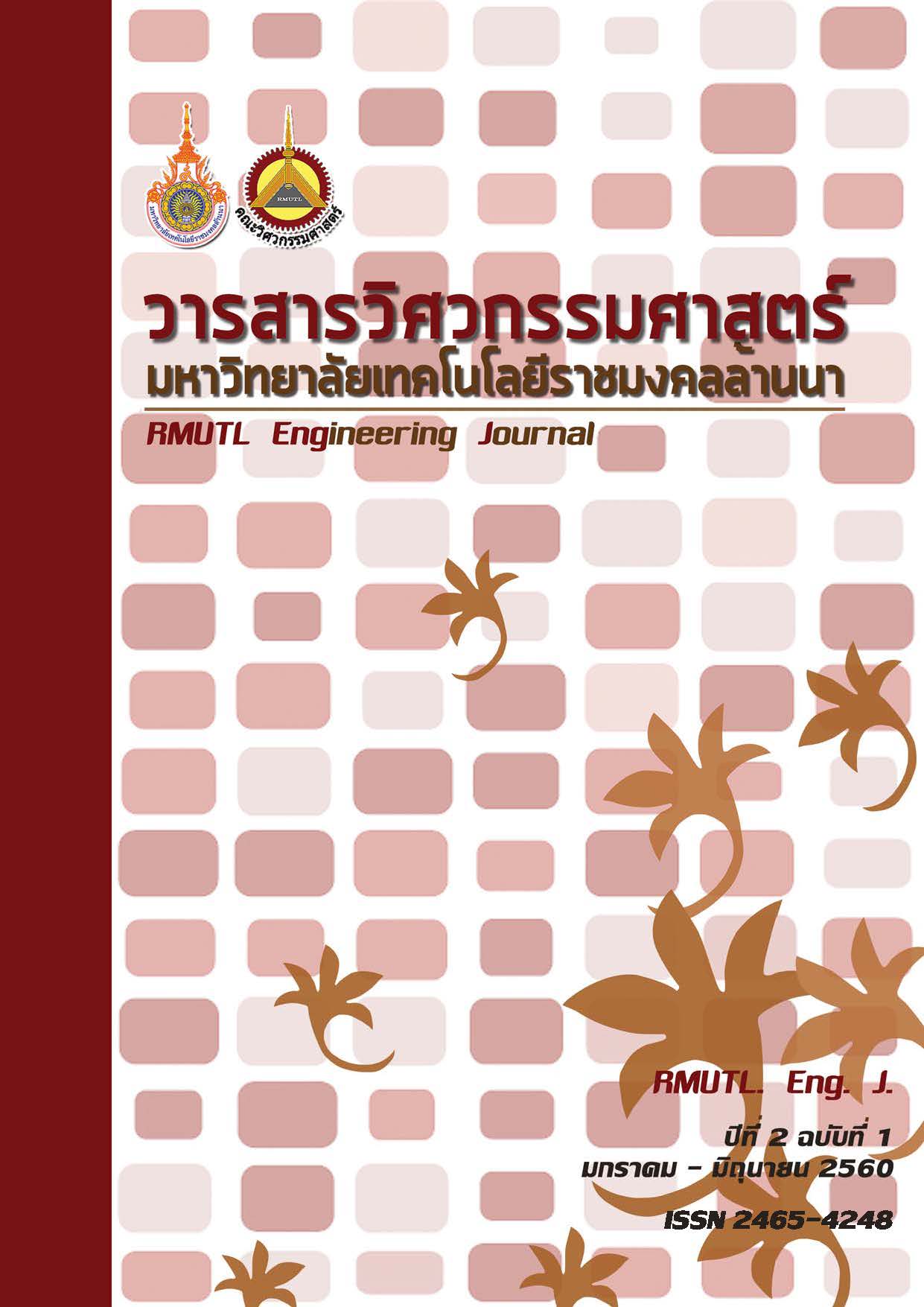The Production of Compressed Charcoal Fuel from the Waste Materials Collected after Processing Khao-Larm
DOI:
https://doi.org/10.14456/rmutlengj.2017.1Keywords:
compressed charcoal fuel, binder, coconut shell, bamboo, thermal energy efficiency.Abstract
This research involves the production of compressed charcoal from the waste materials gathered in Khao-Larm processing. The implemented waste materials, including coconut shell and bamboo, were carbonized and ground before being mixed to the appropriate ratio. In the mixing process, the charcoal powder was combined with 0.5 kilograms of flour and 3 liters of water as a binder in order to produce compressed charcoal fuel. In this experiment there were 11 different formulas of the mixture to be tested. Each mixture was molded and formed into a hexagonal shape by a screw compress machine, and then dehumidified by 8% following the Community Product Standard (TCPS. 238/2547). The thermal efficiency of the compressed charcoal fuel was examined in order to identify the moisture content, thermal energy, compressive stress and fuel consumption quantity by boiling 3 liters of water at 80 degrees Celsius. The result found that the most appropriate ratio was on formula 3, (8.55 kilograms of coconut shell and 0.95 kilograms of bamboo powder). Formula 3 showed the highest efficiency amongst the 10 formulas, with a moisture content of 6.07 percent, an ash content of 10.42 percent, 5748.83 kilocalories per kilogram of thermal energy, 892.530 newton per square millimeters of compressive stress, and 1.917 kilogram per hours of fuel consumption. The key implications of this research are focused on the waste reduction from Khao-Larm processing and the benefits of recycling the bamboo waste into fuel and renewable energy.
References
2. วิไลพร ลักษมีวาณิชย์, กาญจนา สิริกุลรัตน์และณัฐธนัญา บุญถึง.(2554). พฤติกรรมการยอมรับถ่านอัดแท่งจากซังข้าวโพดผสมกะลามะพร้าวของชุมชนตำบลช่างเคิ่ง อำเภอแม่แจ่ม จังหวัดเชียงใหม่ โดยการทนทานแรงกดอัด (Compressive Strength) ของถ่านอัดแท่ง.สาขาวิชาฟิสิกส์, ภาควิชาวิทยาศาสตร์, คณะวิมยาศาสตร์และเทคโนโลยี,มหาวิทยาลัยราชภัฎเชียงใหม่.
3. ดร.กิตติพงษ์ ลาลุน, ผศ.ดร.สมโภชน์ สุดาจันทร์และผศ.ดร.ชัยยันต์ จันทร์ศิริ.(2555) การผลิตถ่านอัดแท่งจากผงถ่านวัสดุชีวมวล*3 ชนิดด้วยชุดเกลียวอัดถ่านอัดแท่ง. ภาควิชาวิศวกรรมเกษตร, คณะวิศวกรรมศาสตร์,มหาวิทยาลัยขอนแก่น.
4. อุกฤษฏ์ โซ่ศรี. (2554). เทคโนโลยีถ่านอัดแท่ง. มหาวิทยาลัยเทคโนโลยีราชมงคลอีสาน วิทยาเขตสกลนคร.
5. กรมพัฒนาพลังงานทดแทนและอนุรักษ์พลังงาน, กระทรวงพลังงาน, [Online], Available: http: //www.dede.go.th/dede/index.php?option=com_content&view=article&id=130%3A2010-05-07-08-10-57&catid=58&Itemid=68&lang=th, 2552.
6. แผนพัฒนาพลังงานทดแทนและพลังงานทางเลือก, [Online],Available:http://www.dede.go.th /dede/images/stories/aedp25.pdf, 2555-2564.
7. ห้องปฏิบัติการเทคโนโลยีพลังงาน ฝ่ายวิจัยพลังงานและสิ่งแวดล้อม สถาบันวิจัยวิทยาศาสตร์และเทคโนโลยีแห่งประเทศไทย, [Online], Available: http://www.charcoal.snmcenter.com/charcoalthai/hot.php.
8. มาตรฐานผลิตภัณฑ์ชุมชน (มผช.)เลขที่ 238/2547 เป็นมาตรฐานเกี่ยวกับเชื้อเพลิงถ่านอัดแท่ง [Online] http://tcps.tisi.go.th/pub%5Ctcps238_47.pdf










